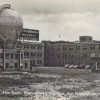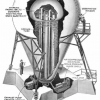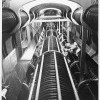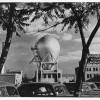The Giant Light Bulb |
|
A PHP Error was encountered
Severity: Notice
Message: Only variables should be passed by reference
Filename: pages/site.php
Line Number: 13

- Genre:Industrial Site
- Comments: 106
- Built:1937
- Opened:1937
- Age:88 years
- Closed:1958
- Demo / Renovated:2015
- Decaying for:57 years
- Last Known Status:Demolished


Photo © 2013 Tom Kirsch, opacity.us
Westinghouse Atom Smasher History
In 1916, the Westinghouse Research Laboratories were established in Forest Hills PA, just outside of Pittsburgh, as the company's mechanics department. Divisions for metallurgy, magnetics, physics and chemistry were created in order to improve the water turbines and electrical generations they were producing.
When the Great Depression struck, the company was forced to lay off numerous scientists and thousands of workers, causing labor unrest at all their plants for a number of years. Westinghouse executives decided to enter the field of nuclear physics not only to improve its public image and acquire scientific talent, but to also ensure the company had a strong presence in this new field, and stay ahead of the competition (particularly General Electric).
A $42,000 research program was initiated, with the main focus on building a particle accelerator to study the effects of high speed subatomic particle collisions. During this time, cyclotrons were the most efficient type of accelerator being used, but the Westinghouse corporation needed something grandiose and flashy to help restore their public image. It was decided that an electrostatic accelerator would pack enough punch to grab people's attention.
Electrostatic accelerators are a type of Van de Graaf Generator, which uses a moving belt to accumulate electric charge at the top of a hollow dome that sits above an insulated column, creating very high voltage DC electricity at low current levels. They can often be seen at science museums or fairs, where touching the globe causes one's hair to stand on end.
Of course, Westinghouse needed a Van de Graaf generator larger than any other that had been built to create both the voltage needed for accelerating particles, and the prestige the company's executives desired. In 1937, a 60 foot (20m) tall pear-shaped tower was constructed at the Forest Hills plant. It utilized two belts which traveled up a 47 foot shaft to energize a domed electrode at the top. The high voltage electricity was then used to accelerate subatomic particles back down through a vacuum tube that ran down the center of the shaft, where they struck a target to create nuclear reactions (see cutaway drawing below). The generator alone would be limited to producing about 1 megavolt due to arcing and corona discharge, so the entire apparatus was enclosed inside an air tank that would be pressurized to 120 psi. This effectively insulated the generator, and allowed it to reach a voltage of 5 megavolts. Although 10 megavolts were hoped for, it was still the most powerful accelerator in the world at that time.
When the atom smasher was unveiled, it was picked up by major national publications, and the company was commended for a farsighted vision into the future of civilian nuclear research. While it helped Westinghouse's publicity, the apparatus saw relatively little use during the first few years. In 1941, the company focus shifted entirely to defense work for the war and nuclear research became highly classified; these operations were moved to secret locations such as Los Alamos. The smasher was too large to be moved however, and was decommissioned, although the massive tank surrounding the generated was used to store compressed air used in jet propulsion research that continued at the Forest Hills lab during World War II.
In 1943, a huge explosion rocked Schenectady NY when a hydrogen storage tank exploded due to internal pressure blowing apart its brittle steel casing. It was built by Chicago Bridge and Iron Works, the same manufacturer as the atom smasher, and many were concerned about the integrity of the atom smasher's massive pressurized air tank. All work was halted at the Forest Hills lab until every weld was x-rayed and all defects were repaired.
After the war, the smasher was once again used by researchers but was beginning to show its age. When Westinghouse built their own smaller and more powerful cyclotron in 1956, the smasher soon became obsolete and was permanently decommissioned in 1958. The lab itself continued working at the Forest Hills site until Westinghouse took a financial nose dive in the 1990s. It sold off its share of power distribution and merged with CBS in 1995; the entire lab facility was shuttered the following year.
The lab remained vacant, with several buildings being demolished as the property changed hands numerous times, until it was bought by D.C. developer Gary Silversmith. Planning to build apartments on the site, he had promised to restore the smasher's iconic "bulb" to its former glory, but to the dismay of many, the generator was knocked off its base and crashed onto its side in 2015. The developer claims the building supporting the smasher was in a state of "severe disrepair" which required its demolition, and he still vows to restore it, but it is unclear how much damage was sustained in the fall, and how the 90-ton steel tank will be relocated due to its massive size and weight.
As of 2016, all the lab buildings have been razed and the smasher is lying on its side in a field of rubble, but the nostalgic can see a scale model of it on display at the Miniature Railroad & Village at the Carnegie Science Center in Pittsburgh. Detailed history of the smasher was culled from this informative opinion piece and a great article on the Physics Central blog.





